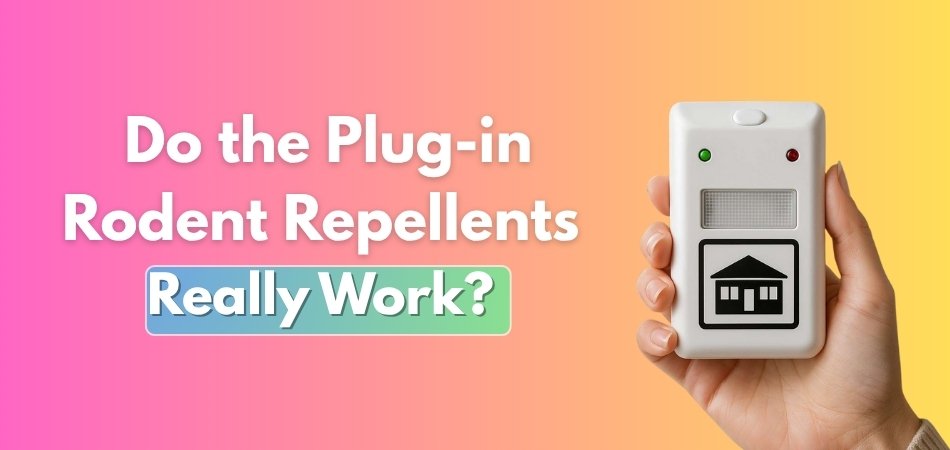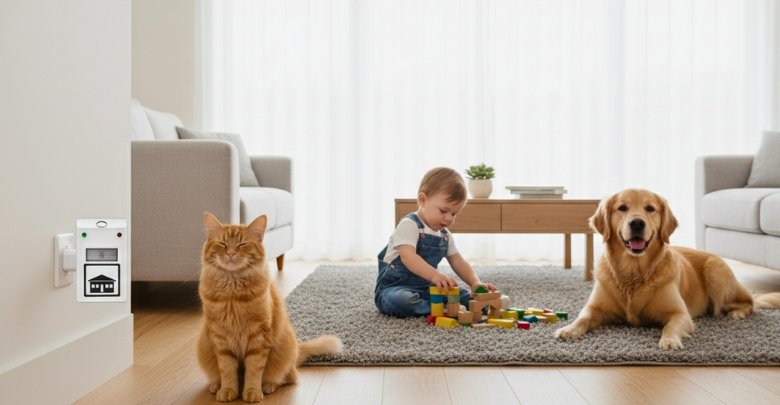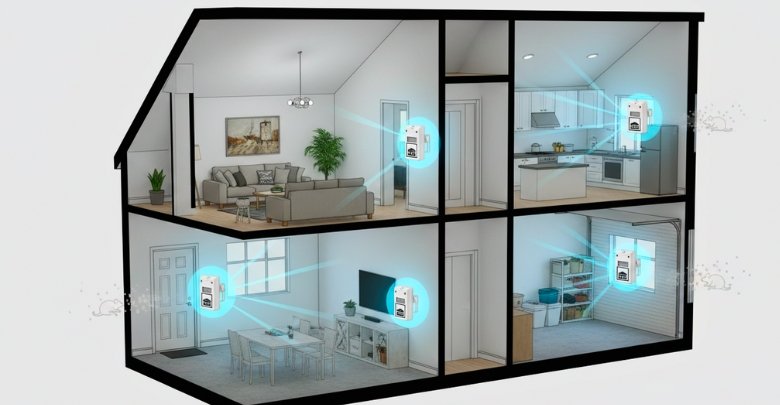Keeping mice or rats away from your home can feel like a never-ending battle, especially when traditional traps or poisons only solve the problem temporarily. That’s where plug-in rodent repellents come in, promising a clean, easy, and chemical-free way to keep pests out for good.
So, Do the Plug-in Rodent Repellents Really Work? The answer depends on several factors. While many users report noticeable improvement after continuous use, others find results vary based on placement, room size, and rodent activity level. These devices are most effective when used consistently and combined with basic preventive steps.
If you’re curious about whether these devices can truly protect your home from unwanted guests, keep reading to discover how they function, what affects their performance, and whether they are worth your trust.
Do the Plug-in Rodent Repellents Really Work?
Keeping rodents out of the house is a challenge many homeowners face, and plug-in repellents promise an effortless solution. These small devices claim to drive pests away using technology instead of traps or chemicals. But how effective are they in real life? Understanding how they function is the first step to knowing if they truly work. Before diving deeper, let’s explore how these plug-in rodent repellents operate and what makes them appealing to many households.

Ultrasonic Wave Technology
Plug-in repellents emit high-frequency ultrasonic waves that disturb rodents’ hearing and nervous systems. These sounds are inaudible to humans but highly irritating to mice and rats, pushing them to leave the area. However, effectiveness may decrease if furniture or walls block the waves, limiting sound reach and overall coverage across multiple rooms.
Electromagnetic Pulse Action
Some advanced models transmit electromagnetic pulses through home wiring to create subtle vibrations inside walls. This makes nesting areas uncomfortable for rodents and insects, driving them away from hidden spaces. According to most Riddex review experiences, this technology is among the most notable features that help devices achieve better coverage than standard ultrasonic-only designs.
Continuous Operation Advantage
These devices work best when running continuously without interruption. Leaving them plugged in ensures a steady disruption to rodents’ environment, making it difficult for them to adapt or return. Since most models consume minimal energy, keeping them active all day remains cost-efficient and effective for long-term pest deterrence in homes or offices.
Eco-friendly and Safe for Families
Plug-in repellents are free from chemicals, toxins, and unpleasant odors, offering a safe option for households with children or pets. They don’t kill pests but repel them naturally, making them an eco-conscious alternative to traps or sprays. This humane approach helps maintain a cleaner and safer indoor environment without harmful residues.
Simple Installation and Low Maintenance
These repellents are plug-and-play devices requiring no setup or special handling. Users can easily connect them to a power outlet and start noticing effects over time. Their compact design fits any room without clutter, making them an appealing choice for people who prefer convenience and minimal maintenance in pest control.
Plug-in rodent repellents can effectively reduce light to moderate infestations when used properly and consistently. Their technology-based mechanism offers a safe, convenient way to deter pests without chemicals. However, combining them with cleanliness and preventive measures ensures the best long-term results for a rodent-free environment.
What Affects Their Overall Performance?
The effectiveness of plug-in rodent repellents depends on several conditions within your home environment. Factors such as room layout, surface materials, and household habits all influence their ability to perform efficiently. To understand why experiences differ from one user to another, let’s look at the main variables that determine how well these devices truly work.
Room Size and Layout
Ultrasonic waves are limited by physical boundaries, meaning a single unit may not cover a large or irregularly shaped area. For best results, use one device per average-sized room. In open spaces or multi-room settings, adding extra units ensures even distribution and prevents untreated areas where rodents might still hide.
Wall Materials and Furniture Placement
Thick walls, carpets, or bulky furniture can absorb or block ultrasonic sound waves, reducing their impact. Avoid placing the device behind objects, curtains, or appliances. Keeping a clear path between the repellent and the target area helps maintain strong sound projection and ensures rodents are exposed to its full effect.
Power Outlet Positioning
The outlet location affects how far the sound waves travel. Plugging the device into a central outlet facing open space rather than corners increases its coverage area. It’s also best to place it near known rodent entry points, like under sinks or near pantry areas, to intercept their movement early.
Cleanliness and Food Management
Rodents are attracted to leftover crumbs, spills, and cluttered areas that provide easy food access. Even the best plug-in repellent can’t overcome a messy environment. Keeping floors clean, sealing food containers, and removing waste regularly strengthen the device’s effect and discourage rodents from returning to the same space.
Consistent Use and Patience
These repellents work gradually, and results may take days or weeks to appear. Switching them off frequently breaks the disruption pattern, allowing rodents to adapt. Keeping them powered continuously ensures lasting performance and prevents pests from becoming familiar with the environment once the ultrasonic activity resumes.
Every home presents different conditions that influence how plug-in rodent repellents perform. With correct placement, consistent use, and a clean environment, these devices can help maintain long-term protection. Paying attention to these small but important details makes a noticeable difference in achieving better results.
Are Plug-in Rodent Repellents Safe for Homes and Pets?
Safety is one of the main reasons homeowners prefer plug-in repellents over chemical-based pest control. These devices operate using sound or electromagnetic signals rather than sprays or poisons. Let’s understand how these devices interact with humans, animals, and the indoor atmosphere.

Chemical-Free and Non-Toxic Operation
Plug-in repellents rely on sound waves or electrical pulses to deter rodents instead of releasing any chemicals. This makes them an excellent fit for homes with children or people sensitive to allergens. Since there are no toxic residues or fumes, daily air quality remains unaffected, ensuring a cleaner and safer living environment.
Safe for Larger Pets and Humans
Most plug-in repellents operate at ultrasonic frequencies that humans and larger pets like cats and dogs cannot hear. They are unaffected by the sound waves and can live comfortably around these devices. This is part of the electronic pest repellent purpose, ensuring safety while discouraging rodents without disrupting normal household routines.
Consideration for Smaller Pets
While these devices are generally safe, small pets such as hamsters, guinea pigs, or gerbils might detect and react to ultrasonic sounds. It’s advisable to keep such animals in rooms without active devices. Monitoring their behavior helps ensure they remain stress-free while you maintain effective rodent prevention throughout your home.
No Harmful Radiation or Emissions
Plug-in repellents do not emit any harmful radiation or chemical vapor. They only produce low-intensity sound or electrical signals that target pests. Unlike some outdated devices, modern versions meet safety standards for household electronics, ensuring that they pose no health risk when used correctly and continuously in residential areas.
Safer Alternative to Traditional Pest Control
Unlike traps or poison-based solutions, plug-in repellents eliminate the risk of exposure to toxic substances or accidental harm to pets. There are no cleanup issues or odor concerns. This makes them a more humane and eco-friendly option for households seeking simple, maintenance-free pest prevention without introducing harmful chemicals.
Plug-in rodent repellents offer a family-friendly approach to pest control, combining safety with convenience. While small pets may need minor precautions, most households can benefit from their chemical-free design. When compared with traditional methods, these repellents stand out as a safer, cleaner, and worry-free way to maintain a rodent-free home.
Common Myths About Plug-In Rodent Repellents Explained
Many homeowners are intrigued by plug-in repellents but often misunderstand how they work. Marketing claims and online discussions sometimes lead to unrealistic expectations about instant or permanent results. Let’s go through some of the most common misconceptions and uncover the truth behind each one.
Myth 1: They Kill Rodents Instantly
Plug-in repellents do not kill rodents. Instead, they make the environment uncomfortable using ultrasonic or electromagnetic signals that drive pests away over time. This process may take days or weeks to show noticeable results, as rodents gradually leave the area once conditions become intolerable for nesting and feeding.
Myth 2: One Unit Can Cover the Entire House
Many users believe that one device is enough for an entire home, but this is not accurate. Ultrasonic waves can’t travel through walls or furniture, which limits their reach. For best results, each room should have its own unit to ensure every area receives consistent coverage and effective rodent deterrence.
Myth 3: Rodents Never Return Once You Use It
Plug-in repellents can discourage rodents while active, but if they are turned off or removed, pests might return. To maintain long-term success, it’s important to keep the device running and combine it with preventive steps such as sealing entry points and maintaining cleanliness throughout the home.
Myth 4: They Work the Same in Every Home
Effectiveness varies depending on factors like home size, wall materials, and layout. What works quickly in one environment may take longer in another. Testing placement spots and running multiple units in larger spaces often produces better results, helping users customize the setup for their specific needs and surroundings.
Myth 5: They Are Ineffective Because Results Take Time
Some users assume the devices don’t work simply because they don’t see instant changes. In reality, repellents need consistent operation to affect rodent behavior. Patience and proper use are key. Over time, the steady disruption of ultrasonic signals makes the area less suitable for rodents, leading them to relocate naturally.
Understanding these myths helps set realistic expectations for plug-in rodent repellents. While they don’t provide instant elimination, they offer a humane and chemical-free solution for reducing infestations. Using them correctly, with patience and proper coverage, can lead to a noticeable difference in maintaining a cleaner, pest-free living space.
Where Should You Place Plug-in Rodent Repellents for Best Results?
Proper placement plays a major role in how effectively plug-in rodent repellents work. Even the best device can fail to deliver results if positioned incorrectly. Since these repellents rely on sound waves or electromagnetic signals, they must be placed in open areas where the signals can travel freely without barriers or obstructions. Here is where you should plug in rodent repellents.

Near Common Entry Points
Place devices close to doorways, vents, or small wall gaps where rodents often enter. These spots serve as first-contact areas that prevent pests from spreading deeper into your home. For example, installing one near the garage or basement entrance helps discourage mice from crossing into living spaces.
Under Sinks and Inside Kitchens
Rodents are drawn to food sources, and kitchens often provide easy access. Placing a repellent under the sink or behind cabinets keeps pests away from crumbs, pipes, and hidden corners. Make sure the device faces outward and is not blocked by trash bins or appliances to allow the sound to circulate properly.
Basements, Attics, and Storage Areas
These quiet and dark locations are common nesting zones for rodents. Positioning a repellent near stored boxes or along basement walls helps interrupt their hiding routines. In attics, one near the insulation or entry point where scratching noises are heard can reduce nesting and drive rodents to relocate elsewhere.
Maintain Open Space Around the Device
Avoid placing repellents behind furniture, curtains, or large objects, as these can absorb or block sound waves. Ultrasonic signals need open space to spread evenly. If you hear scratching behind the wall, try plugging one unit on each side of that area to improve sound coverage and performance.
Even Distribution Across Multiple Rooms
Using one unit per room is ideal for consistent results. Spacing them evenly prevents rodents from moving between untreated areas. Check each device regularly, understanding indicator lights to confirm it is powered and functioning properly. Consistent use across connected rooms increases efficiency and long-term effectiveness.
Thoughtful placement can significantly boost the success rate of plug-in rodent repellents. By targeting high-activity areas, maintaining clear space, and ensuring all devices are active, you create a protective zone that discourages rodents from returning. A little planning goes a long way toward keeping your home clean and pest-free.
Maintenance Tips to Keep Your Plug-in Devices Effective
Like any electronic device, plug-in rodent repellents need a bit of care to stay efficient. Regular maintenance not only extends their lifespan but also ensures they continue to function at their full potential. Here are some easy yet important maintenance practices that help maintain consistent performance.
- Monitor Lifespan and Replace When Needed: Most plug-in repellents last between three to five years, depending on the brand and usage. If you notice reduced activity or the indicator light stops working, it’s time to replace the device for better and continuous pest control.
- Keep Vents and Surfaces Clean: Dust can block sound output and affect performance. Wipe the device’s surface and vents regularly using a dry cloth. Clean surroundings also help ultrasonic waves spread more efficiently, ensuring the device performs at its intended capacity.
- Check Indicator Lights Frequently: Indicator lights show whether the device is powered and active. Make it a habit to check them weekly. A steady or blinking light confirms the device is working, while no light may indicate a loose connection or technical fault.
- Upgrade Models Every Few Years: Pest-control technology improves with time. Upgrading to a newer model ensures stronger frequency range, energy efficiency, and better safety features. Newer versions are designed to adapt to modern home layouts and deliver improved rodent deterrence.
Regular upkeep and correct use make plug-in rodent repellents a worthwhile addition to your pest-prevention plan. By keeping them clean, checking lights, and upgrading when needed, you can enjoy long-lasting performance and maintain a rodent-free home efficiently.
Frequently Asked Questions
Choosing the right plug-in rodent repellent can raise a few questions, especially after learning how they work and how to maintain them. Below are some of the most common questions people often ask when deciding whether to buy or continue using these handy devices.
How Long Does It Take to See Results From Plug-in Rodent Repellents?
Most users start noticing results within one to two weeks of continuous use. The sound waves gradually drive rodents away rather than offering instant results. Keeping the device plugged in without interruption ensures faster and more consistent effectiveness over time.
Can I Use Plug-in Repellents Alongside Other Pest Control Methods?
Yes, you can. These repellents work even better when paired with other preventive measures, such as sealing holes or maintaining cleanliness. Combining multiple methods provides a stronger defense and helps eliminate existing rodents while preventing new ones from entering.
Do Plug-in Repellents Work on Insects as Well?
Some models can affect insects like spiders, ants, and cockroaches, depending on their frequency range. However, their impact on insects is usually lighter than on rodents. For best results, choose a model specifically labeled for both rodents and insects.
Can Plug-in Devices Be Used in Garages or Outdoor Areas?
Plug-in repellents are primarily designed for indoor use. However, you can use them in covered garages or storage sheds with power outlets. Avoid exposing the device to direct moisture, rain, or extreme temperatures to prevent damage and maintain safety.
Do Plug-in Rodent Repellents Interfere With Wi-Fi or Electronics?
No, these devices do not interfere with Wi-Fi, mobile signals, or electronic appliances. They work on sound frequencies that only affect pests. You can safely use them near routers, televisions, or other household electronics without worrying about connectivity issues.
What Should I Do If Rodents Return After Some Time?
If rodents reappear, check your home for open entry points or food sources. Clean affected areas and move the device closer to the active zone. Adding extra units in larger spaces can also help restore consistent protection effectively.
Can I Leave Plug-in Repellents on While Sleeping?
Yes, they are completely safe to use overnight. The ultrasonic sound is inaudible to humans, so it won’t disturb your sleep. In fact, running the device all night improves consistency and prevents rodents from returning during quiet hours.
Concluding Lines
After exploring their functions and real-world results, it becomes easier to answer the question, Do the Plug-in Rodent Repellents Really Work. These devices can be helpful for reducing mild infestations and preventing new pests from entering, especially when used properly and placed in the right locations.
Their biggest strengths are safety and convenience. Since they do not rely on poisons or traps, they make pest control simple for families with children or pets. Consistent use and regular maintenance often lead to better, long-term results in most homes.
While plug-in repellents may not completely replace professional pest control, they serve as a reliable first line of defense. If used with preventive habits and patience, they can play an important role in keeping your home clean and rodent-free.






